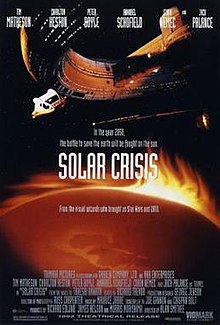Solar Crisis is a 1990 Japanese-American science fiction thriller film directed by Richard C. Sarafian (credited as Alan Smithee). The screenplay was written by Joe Gannon and Tedi Sarafian (credited as Crispan Bolt), based on Takeshi Kawata's 1990 novel Crisis 2050; Kawata co-produced the film. The film was first released in Japan in 1990, and in the United States in 1992.
| Solar Crisis | |
|---|---|
 Theatrical release poster | |
| Directed by | Richard C. Sarafian (as Alan Smithee) |
| Screenplay by |
|
| Based on | Crisis 2050 by Takeshi Kawata |
| Produced by | Richard Edlund James Nelson |
| Starring |
|
| Cinematography | Russell Carpenter |
| Edited by | Richard Trevor |
| Music by | Maurice Jarre |
Production companies | |
| Distributed by | Shochiku (Japan) Trimark Pictures (United States)[1] |
Release dates |
|
Running time | 111 minutes |
| Countries | |
| Language | English |
| Budget | $43 million[1] |
The cast features Tim Matheson as Steve Kelso, Charlton Heston as Admiral "Skeet" Kelso, Peter Boyle as Arnold Teague, Annabel Schofield as Alex Noffe, Corin Nemec as Mike Kelso, and Jack Palance as Travis. The executive producers were Takeshi Kawata and Takehito Sadamura. FX cinematographer Richard Edlund and veteran sound editor James Nelson served as producers.
Plot
editTo stop a solar flare from destroying the Earth, Steve Kelso is tasked to drop an artificially intelligent bomb on the Sun from the spaceship Helios. Arnold Teague, who believes the danger to be overstated, attempts to sabotage the mission so he can profit from the panic. Teague's agents on Earth clash with Kelso's father, Admiral "Skeet" Kelso, and his son, Mike.
Cast
edit- Tim Matheson as Steve Kelso
- Charlton Heston as Admiral "Skeet" Kelso
- Peter Boyle as Arnold Teague
- Annabel Schofield as Alex Noffe
- Corin Nemec as Mike Kelso
- Jack Palance as Travis
- Tetsuya Bessho as Ken Minami
- Dorian Harewood as Borg
- Paul Koslo as Haas
- Sandy McPeak as Gurney
- Silvana Gallardo as T.C.
- Dan Shor as Harvard
- Scott Allan Campbell as McBride
- Frantz Turner as Lamare
- Paul Williams as Freddy The Bomb (voice)
- Brenda Bakke as Claire Beeson
- Michael Berryman as Matthew
- Roy Jenson as The Bartender
- H.M. Wynant as IXL executive #1
Production
editIn November 1989, Solar Crisis began shooting, with an announced budget of US$30 million (equivalent to $70 million in 2023). Nippon Steel, one of the investors, announced a Japanese theme park based on the film.[3]
Scientist Richard J. Terrile served as a technical advisor. He at first tried to convince the filmmakers to avoid sending a crew to the Sun, calling it unscientific. When it was explained to him that audience would demand such a plot point regardless of scientific accuracy, Terrile said he realized his job was to make impossible situations sound more plausible.[4]
Release
editTV Guide quoted the final budget as US$43 million (equivalent to $110 million in 2023). The film opened in Japan in 1990, where it underperformed. In response, the producers extensively recut and reshot scenes to secure an American distributor. Sarafian had his name removed from the credits and replaced with the Directors Guild of America alias "Alan Smithee". Sarafian's son Tedi, who performed rewrites, was credited as "Crispan Bolt".[1]
Producers Edlund and Nelson also brought in Rene Balcer to do uncredited rewrites.[citation needed]
Reception
editTV Guide rated it 2/5 stars and wrote:
"Enjoy its awesome visuals or scorn its slipshod execution, Solar Crisis amounts to one small step for cinema, one giant leap for Alan Smithee."[1]
See also
edit- Solar Attack (2006), a direct-to-video film by Lions Gate Entertainment with a somewhat similar plot
- Sunshine (2007), a film with a similar premise of dropping a bomb into the Sun to save the Earth
- Sun in culture
References
edit- ^ a b c d "Solar Crisis". TV Guide. Archived from the original on 2017-08-26. Retrieved 2017-07-13.
- ^ a b "KURAISHISU NIJU-GOJU NEN (1990)". British Film Institute. Archived from the original on 2017-09-17. Retrieved 2017-07-13.
- ^ Pond, Steve (1989-11-10). "'TALKING' ABOUT BLOCKBUSTERS". The Washington Post. Retrieved 2017-07-13.
- ^ Kirby, David A. (2011). Lab Coats in Hollywood: Science, Scientists, and Cinema. MIT Press. pp. 147–149. ISBN 9780262294867.
Bibliography
edit- Kawata, Takeshi (1990). Crisis 2050.